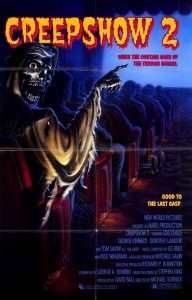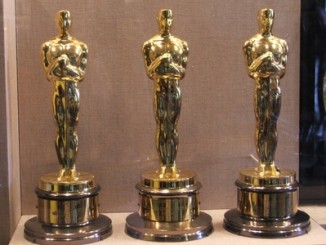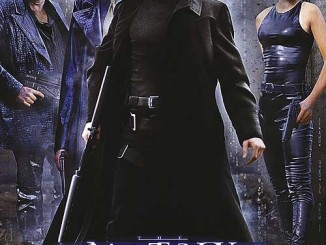In a multi-part series, Comic Book Film Editor William Gatevackes will be tracing the history of comic book movies from the earliest days of the film serials to today’s big blockbusters and beyond. Along with the history lesson, Bill will be covering some of the most prominent comic book films over the years and why they were so special. This time, we’ll continue our look at EC Comics with a number of films the company inspired in the 1980s and 1990s.
 If EC Comics helped redefine horror for the 1950s (and beyond), then you can make the argument that George Romero did the same for the 1960s (and beyond) and Stephen King did it for the 1970s (and beyond).
If EC Comics helped redefine horror for the 1950s (and beyond), then you can make the argument that George Romero did the same for the 1960s (and beyond) and Stephen King did it for the 1970s (and beyond).
Romero’s 1968 film, Night of the Living Dead, revolutionized the world of film horror, creating a still existing zombie craze but also showing, like the EC books, that you can slip social satire and commentary into a film about cannibalistic ghouls. The prolific King changed the way the world looked at print horror with works such as Carrie, The Shining, The Stand, amongst others, much of which was adapted for both the big and small screen.
Naturally, both men would be influenced by the EC books, and they showed their love for the company’s offerings when they collaborated on the 1982 film, Creepshow.
 While Creepshow was not directly adapted from any particular EC comic, the tone and style of the film has EC written all over it. The film has a similar structure as the Amicus Productions adaptations from the 70s, with five independent stories joined together by a framing sequence (with a “Creepshow” comic book serving as an instigator for each of the segments). The segments themselves, all directed by Romero, were either adapted from King’s short stories or written specifically for the screen by King himself.
While Creepshow was not directly adapted from any particular EC comic, the tone and style of the film has EC written all over it. The film has a similar structure as the Amicus Productions adaptations from the 70s, with five independent stories joined together by a framing sequence (with a “Creepshow” comic book serving as an instigator for each of the segments). The segments themselves, all directed by Romero, were either adapted from King’s short stories or written specifically for the screen by King himself.
But those stories were essentially love letters to the EC Comics that were published three decades before. They consisted of many of the staples that made EC Comics great— gallows humor, the wronged dead coming back to life to exact vengeance, and plenty of O’Henry-esque twists.
The pair reunited five years later for Creepshow 2, with Romero stepping down as director and instead acting as a screenwriter who adapted King’s stories for the film:
:
There are only three stories this time instead of five, but the “Creepshow” comic book plays a role once again in the framing sequence.
There was a Creepshow III made in 2007…
but this film was a sequel in name only. Neither King nor Romero had anything to do with it, the comic book framing sequence was removed, and replaced by an interwoven narrative connecting the various segments, ala Pulp Fiction. Tom Savini, friend and frequent collaborator to George Romero, has stated that 1990’s Tales From the Darkside: The Movie, was the ipso facto sequel to Creepshow 2.
Stephen King and George Romero do reunite for the film, which was a big screen adaptation of the syndicated TV series of the same time, but only on one of the three segments (“Cat From Hell”) and only as writers (the film was directed not by Romero, but by John Harrison). The film does feature a similar framing sequence to the first two Creepshow films, but without the comic book framing sequence.
In 1985, another story from an EC book was adapted for the big screen, although it is a bit hard to make the connection. The film? Weird Science.

The film, written and directed by John Hughes, loosely adapts “Made of the Future” from Weird Science #5 (1951). Very loosely.
The original story is about a man, just jilted by his fiancée, who inadvertently bumps into a tour group from the future. On a lark, he returns to the future with the tourists and finds that men of the future are able to buy kits to construct their own wives. He brings a kit back home and, well, creates his own wife.
The film centers on a pair of unpopular teenagers named Wyatt (Ilan Mitchell Smith) and Gary (Anthony Michael Hall). Their answer to improve their social standing involved a computer, data concerning their ideal woman, hacking a Government computer for more power, and a Barbie doll. These elements combine to form Lisa (Kelly LeBrock), an incredibly attractive woman who exhibited super powers and existed, literally, only to serve Wyatt and Gary.
The two stories were so different that I, for many years, wasn’t able to put two and two together and realize that they were connected. But connected they are, apparently.
 In the 1990s, HBO created a TV series based on the EC books called Tales from the Crypt. Every episode of the series, which ran from 1989 to 1996, was adapted from an EC book. The series was produced by an all-star lineup of Hollywood heavyweights, including Richard Donner, Walter Hill, Joel Silver, David Geffen and Robert Zemeckis and many Hollywood stars appeared in the series, either in front of the camera (Demi Moore, Joe Pesci, Whoopi Goldberg, Brad Pitt) or behind the camera, as director (Arnold Schwarzenegger, Michael J. Fox, Tom Hanks).
In the 1990s, HBO created a TV series based on the EC books called Tales from the Crypt. Every episode of the series, which ran from 1989 to 1996, was adapted from an EC book. The series was produced by an all-star lineup of Hollywood heavyweights, including Richard Donner, Walter Hill, Joel Silver, David Geffen and Robert Zemeckis and many Hollywood stars appeared in the series, either in front of the camera (Demi Moore, Joe Pesci, Whoopi Goldberg, Brad Pitt) or behind the camera, as director (Arnold Schwarzenegger, Michael J. Fox, Tom Hanks).
Due to the popularity of the TV series, the Tales from the Crypt brand was brought to the big screen in a planned trilogy of feature films. These films acted essentially as longer episode of the TV series, with each film being introduced by the show’s host, the Crypt Keeper, yet none were directly adapted from an EC comic book. The first film in the series was 1995’s Tales from the Crypt Presents: Demon Knight.
The script for Demon Knight was bouncing around Hollywood for years before the Tales from the Crypt name was attached to it. The plot involved a supernatural and long-lived guardian (William Sadler) who exists only to kill demons, and a stand-off between the guardian and a high level demon (Billy Zane) in a small New Mexico town. The follow-up was 1996’s Tales from the Crypt Presents: Bordello of Blood.
 This installment was originally planned to be a zombie film set in New Orleans called “Dead Easy,” but that film morphed into a vampire flick where an acerbic private eye (Dennis Miller) takes a case of a woman (Erika Eleniak) who is searching for her missing brother (Corey Feldman). The trail leads to a bordello housing a legion of vampire prostitutes led by the “mother of all vampires” (Angie Everhart). The most memorable part of the movie, for me, was Miller’s character going into battle against the vampires with a Super Soaker loaded with Holy Water. I thought that was inventive.
This installment was originally planned to be a zombie film set in New Orleans called “Dead Easy,” but that film morphed into a vampire flick where an acerbic private eye (Dennis Miller) takes a case of a woman (Erika Eleniak) who is searching for her missing brother (Corey Feldman). The trail leads to a bordello housing a legion of vampire prostitutes led by the “mother of all vampires” (Angie Everhart). The most memorable part of the movie, for me, was Miller’s character going into battle against the vampires with a Super Soaker loaded with Holy Water. I thought that was inventive.
Bordello of Blood was a box office failure. The third film of the trilogy, named Ritual, was never released in the U.S. and was only released overseas with all mentions of Tales from the Crypt removed from it (they were replaced for the U.S. DVD release). The film centered on a voodoo cult and zombies and starred Tim Curry, Jennifer Grey and Craig Sheffer. A company by the name of EMO Films had picked up the rights to the EC Comics line in 2009, so perhaps we’ll see more adaptations in the future.
Next time, we’ll cover some underground comix entering the world of underground film.




